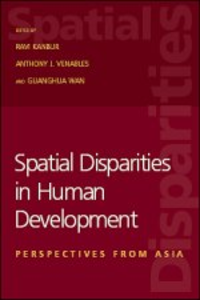Income inequality in rural China: regression-based decomposition using household data
Wan, Guanghua, and Zhou, Zhangyue (2006) Income inequality in rural China: regression-based decomposition using household data. In: Kanbur, Ravi, Venables, Anthony J. , and Wan, Guanghua, (eds.) Spatial Disparities in Human Development: perspectives from Asia. United Nations University Press, Tokyo, Japan, pp. 115-132.
|
PDF (Published Version)
Restricted to Repository staff only |
||
![[img]](https://researchonline.jcu.edu.au/3630/2.hassmallThumbnailVersion/3630_Wan_Zhou_2006.jpg)
|
Image (JPEG) (Book Cover)
Download (8kB) |
Abstract
[Extract] Many studies have appeared, in both English and Chinese, focusing on income distribution in rural China1. They point to a worsening trend since the late 1970s when China initiated economic reforms. Such a trend has serious implications for China's ability to maintain sustainable growth and, if unabated, will undermine social and political stability. The issue of income distribution ranks as one of the top priorities in the government's policy agenda. Two very important national conferences held in March 2003 the National People's Congress and the Chinese People's Political Consultative Conference expressed unprecedented concerns about rural income and income inequality. Although a consensus has been reached about the increasing trend in income inequality in rural and urban China, this is not the case regarding the causes of such increases. Generally speaking, variables affecting income generation will also determine income inequality. Thus, economic theory and common knowledge can be used to identify these variables. In other words, one could easily compile a list of factors that may explain income gaps, such as different resource endowments and policy biases. However, for the purpose of setting policy priorities, it is necessary to rank the variables in terms of their relative contributions to total inequality. This usually requires inequality decomposition. Conventional approaches to inequality decomposition typically follow Shorrocks (1980, 1982, 1984) and Bourguignon (1979). Under these frameworks, one can carry out decomposition either by population subgroups or by factor components. The former produces the so-called "within" and "between" components. It has been used to examine issues such as urban-rural income gaps, male-female wage differentials, and So on (for a recent reference, see Shorrocks and Wan 2004a). For example, Kanbur and Zhang (1999) find that 70-78 per cent of regional income inequality in China is made up of the "between" (urban and rural) component, and the rest is the "within" component. This kind of decomposition is silent on the fundamental determinants of the two components. Also, the decomposition is likely to produce spurious results. For example, decomposition of wage inequality by gender might give rise to a sizeable between-gender component. However, this may have little to do with sex discrimination in the workplace if females are less educated before they enter the labour market, a not uncommon phenomenon in many developing countries. Similarly, a large between-race component may have little to do with skin colour unless other personal attributes such as education, age or occupation can be assumed to be identical. Clearly, one must be able to control for other factors in order to identify and measure the contribution of a particular variable. This is not possible with the conventional approaches. Decomposition by factor components requires complete information on all income sources. It also requires an identity that expresses total income as a sum of factor incomes. Apart from a data unavailability problem, this approach cannot be used to quantify the contributions of fundamental determinants to income inequality either. For example, it is known that income is determined by education, experience and other personal or household characteristics. These fundamental determinants affect all sources of income, including wages, investment returns and transfer income. It would be interesting and useful to decompose total inequality into components associated with each of the fundamental determinants. However, decomposition by factor components allows one to attribute total inequality only to the income sources, not to the fundamental determinants. This chapter contributes to the literature on income inequality in rural China in a number of ways. It represents an early attempt to analytically identify the fundamental determinants of income inequality in rural China. The use of regression-based decomposition is novel in that it allows ranking of these determinants according to any inequality measure. Moreover, household -level data are used in this chapter, complementing the existing literature, which is mostly based on aggregate data. In the next section, we present a brief discussion on income disparity in rural China and on the data source. Section 3 describes the regression based decomposition technique and the income generation function. This is followed by interpretation of the decomposition results and policy implications in section 4. Section 5 concludes.
| Item ID: | 3630 |
|---|---|
| Item Type: | Book Chapter (Research - B1) |
| ISBN: | 978-92-808-1122-3 |
| Keywords: | income inequality; rural China |
| Additional Information: | This publication does not have an abstract. The introduction is displayed as the abstract |
| Date Deposited: | 19 Nov 2009 03:31 |
| FoR Codes: | 14 ECONOMICS > 1402 Applied Economics > 140299 Applied Economics not elsewhere classified @ 100% |
| SEO Codes: | 91 ECONOMIC FRAMEWORK > 9199 Other Economic Framework > 919999 Economic Framework not elsewhere classified @ 100% |
| Downloads: |
Total: 6698 Last 12 Months: 9 |
| More Statistics |



